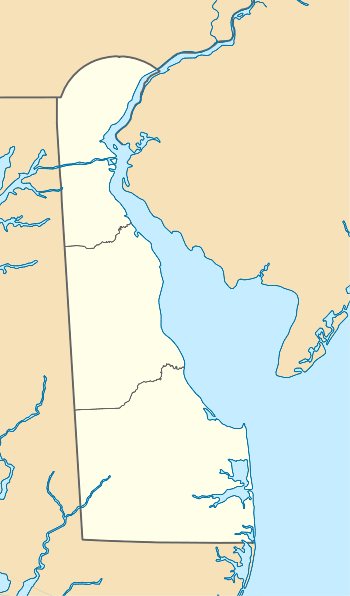Aspendale (Kenton)
Aspendale is a historic house and plantation property on Delaware Route 300 west of Kenton, Kent County, Delaware, United States. The main house, built 1771-73, has been in under a single family's ownership since construction, and is a rare well-preserved example of a Georgian "Quaker plan" house. It was listed on the National Register of Historic Places and declared a National Historic Landmark in 1970.[2][3]
Aspendale | |
%2C_Kenton_vicinity%2C_(Kent_County%2C_Delaware).jpg) Aspendale, HABS Photo, 1982 | |
  | |
| Location | 1 mile (1.6 km) west of Kenton, Delaware on Delaware Route 300 |
|---|---|
| Coordinates | 39°13′18″N 75°41′9″W |
| Area | 210 acres (85 ha) |
| Built | 1771–1773 |
| Architect | Unknown |
| Architectural style | Georgian |
| NRHP reference No. | 70000170 |
| Significant dates | |
| Added to NRHP | April 15, 1970[1] |
| Designated NHL | April 15, 1970[2] |
Description and history
Aspendale is located about 1 mile (1.6 km) west of Kenton, on the north side of Delaware Route 300. The property is over 200 acres (81 ha) in size, consisting of fields and woodlands roughly bisected by the road. The main house is set near the road surrounded by landscaping. It is a modest 2-1/2 story brick structure, with a gabled roof and end chimneys joined by curtain walls. A single-story gable-roofed wood-frame addition extends to one side. The front and rear of the main block consist of brick laid in Flemish bond, while the ends are laid in common bond. The main facade is three bays wide, with a symmetrical arrangement of sash windows around a center entrance. The ground-floor windows, in a traditional Delaware pattern, have paneled shutters, while the upper level windows have louvered shutters. The interior has a rare example of a "Quaker plan", with a large front-to-back parlor on the east side, and a study and living room separated by a hall on the west side. These rooms all exhibit original woodwork and other features.[3]
The land on which the house stands was deeded in 1770 to Charles Numbers, and was (as of its landmark designation in 1970) still in the hands of Numbers descendants. The house was built between 1771 and 1773. The large parlor was subdivided with partitions in the 19th century, and a Victorian porch was added; both of these elements were reversed during a restoration of the property in the 1960s.[3]
See also
References
- "National Register Information System". National Register of Historic Places. National Park Service. January 23, 2007.
- "Aspendale". National Historic Landmark summary listing. National Park Service. Retrieved 2007-09-27.
- Patricia Heintzelman and Charles Snell (August 30, 1974). "National Register of Historic Places Inventory-Nomination: Aspendale" (pdf). National Park Service. Cite journal requires
|journal=(help) and Accompanying 5 photos, exterior, 1974 and undated (1.60 MB)
External links
| Wikimedia Commons has media related to Aspendale (Kenton). |
- Historic American Buildings Survey (HABS) No. DE-143, "Aspendale, Route 300 (Downs Chapel), Kenton, Kent County, DE", 27 photos, 2 color transparencies, 11 measured drawings, 17 data pages, 3 photo caption pages, supplemental material

